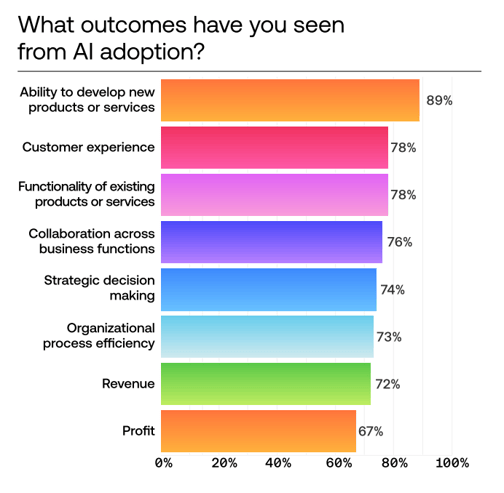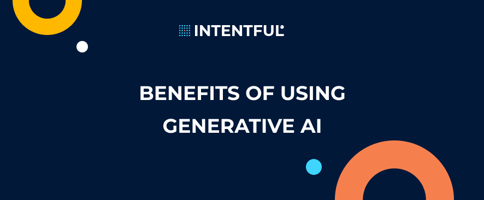By 2025, generative AI is expected to contribute 10% of all global data and 30% of all outbound...
100 Generative AI Use Cases for Enterprises
Generative AI is taking the world by storm. Never before has the transformation been so fast and so fundamental. Companies around the world are exploring how they can start using AI in their work – many are still in the discovery phase, but numerous organizations are already actively applying AI in their work.
According to the Scale AI Readiness report, here is what the enterprises say:

Generative AI is most advanced with text-to-text solutions now. There have been unbelievable advances in images and videos, and they are very close for production enterprise use, but there are a number of issues that still need to get resolved (mostly in the IP space) before they can be seamlessly integrated into everyday work.
Generative artificial intelligence is transforming the way we interact with written content. From content creation to summarization, to smart information search, to optimizing review processes, enterprises are now able to achieve far greater efficiencies, saving a considerable amount of time.
Intentful is about content. We leverage data and AI to create content in whole new ways, making it relevant to audience needs and interests. Since we started working with generative AI in 2021, we’ve helped our clients with multiple use cases for written content production. And there are so many things on where and how you can apply gen AI in your work.
In this blog post, we include only 100 use cases of generative AI. But the opportunities and use cases are endless.
Train or Fine-tune AI and Have a Human Supervisor Involved
For the AI-powered content to be of the highest possible quality, two key prerequisites must be met. First, an AI model needs to “know” all the relevant data for each case. Second, editors and subject matter experts must review the outputs to ensure they are factually correct, unbiased, and have the required voice and style.
AI is not a replacement for human talent. The foundational model does not know your business, or brand of guidelines until you fine-tune it accordingly.
At Intentful, these are the foundational principles of any content creation project we work on.
So let’s take a look at the use cases where generative AI can help save time and budget.
-
Use AI as your writing assistant – you define what you want to say, what facts to include, and what message to communicate. AI will turn your thoughts into a structured format of your choice in seconds. We are greatly discouraging the use of generative AI as a replacement for all written content.
-
Internal knowledge base creation and expansion for companies, making it easier for employees to access relevant information quickly. Generative AI can help streamline the process of creating, updating, and organizing documentation on company policies, procedures, and best practices.
-
AI-generated content for customer support knowledge bases, streamlining the process of creating and maintaining up-to-date and easily searchable information for support agents to reference when helping customers. This includes troubleshooting guides, FAQ sections, and tutorial materials.
-
AI-assisted marketing content creation at scale, leveraging data insights to support content creators and marketers in producing highly targeted and relevant content. AI aids human professionals in identifying and utilizing data-driven input, empowering them to efficiently generate content that resonates with their audience while effectively scaling their efforts.
-
Product descriptions that highlight the features and benefits of products, helping to increase sales and customer engagement. Turn bullet points into beautiful copy in seconds.
-
How-to guides that provide step-by-step instructions for various tasks, such as cooking, DIY projects, and home repairs. For businesses, these can be onboarding manuals, platform guidelines, or company policies.
-
Ad copy promoting a product or service and driving traffic to a website or landing page.
-
Blog posts providing information, educating, and entertaining readers.
-
Email sequences sent to subscribers over a period of time to build relationships with them and drive sales.
-
Social media posts promoting long-form articles, building brand awareness, and connecting with consumers
AI to Add Efficiency to Legal Content Management
-
AI-assisted drafting of standardized legal documents, such as contracts, agreements, motions, briefs, and pleadings, serving as a support tool for legal professionals. By leveraging a fine-tuned model, the AI can streamline the initial drafting process, allowing legal experts to invest more time in reviewing and refining the generated content to ensure factual accuracy, compliance, and adherence to the required voice and style. This collaboration between AI and legal professionals can save enterprises time and money on legal fees while maintaining the highest quality standards.
-
AI-assisted document analysis for legal workflows, such as compliance and due diligence tasks, supporting legal professionals in processing large volumes of documents more efficiently. Human expertise remains invaluable in refining the AI's analysis and validating its output to ensure accuracy and compliance with legal requirements.
Marketing Content Personalization
-
AI-driven content personalization without using personal data, leveraging insights from users' content preferences, and interactions with websites or apps. AI algorithms create tailored product recommendations, ads, emails, landing pages, and interactive content that caters to each user's interests, without relying on personal data for customization. This achieves a balance between personalization and privacy.
-
AI can create social media content plans and captions for multiple audience segments.
-
Chatbots that offer personalized customer service, answering queries and giving recommendations based on people’s interests and questions. These AI-powered bots create an enhanced user experience by delivering relevant information and assistance tailored to customers' needs.
AI for Translation and Transcreation
Major advances have been made in how AI works with languages. For example, Meta has recently announced Massively Multilingual Speech AI research models can identify more than 4,000 spoken languages, 40 times more than any known previous technology. Translation and transcreation have always been a time-consuming and expensive process. With artificial intelligence, enterprises can now automate translation, saving time and resources while improving accuracy and efficiency.
-
Website localization allows enterprises to reach a global audience and improve their online presence by being able to create more relevant content in a user’s native language.
-
Multilingual customer support via chatbots, answering queries and providing information in several languages.
-
AI-powered translation of marketing content, such as ads and social media posts, legal documents, technical manuals, as well as subtitles and captions.
-
Voiceovers in different languages, providing a more personalized experience for customers who prefer to listen rather than read.
-
AI-assisted automatic summarization of meeting transcripts and recordings in multiple languages, making content more accessible and informative for global teams and stakeholders. By providing succinct summaries and translations of key points and action items, enterprises can ensure that important information is understood and effectively communicated across their organization, regardless of language barriers.
-
Transcreation of content for international marketing campaigns, ensuring cultural nuances and context is preserved while maintaining the intended message and tone.
-
Sentiment analysis for customer reviews and feedback in multiple languages, allowing businesses to understand the emotions and opinions of consumers globally.
-
Product and service user guides in multiple languages, ensuring international customers can access and understand essential information.
-
Automating the transcription and translation of podcasts, interviews, or webinars for global audiences, making content more accessible.
AI for Content Summarization
-
AI-generated executive summaries for lengthy reports, whitepapers, or research documents, enabling readers to grasp the main points quickly.
-
Auto-summarization of news articles, breaking down complex information into digestible summaries for easier consumption.
-
Shortened versions of long-form content for social media or newsletters, encouraging click-throughs and engagement.
-
AI-generated meeting summaries to capture the key points and action items from team discussions or client calls.
-
Simplifying complex documents, such as contracts or agreements, into more understandable summaries for non-legal professionals.
AI for SEO & Keyword Research
-
AI-enhanced content optimization, analyzing your website's content to identify areas for improvement and suggest relevant keywords and phrases based on search intent, allowing you to create content that better serves user needs and performs well on search engines.
-
AI-based content gap analysis to identify topics or keywords that competitors are ranking for but your website isn't, allowing you to create content to fill those gaps.
-
Automating meta tags, titles, and descriptions based on best SEO practices and targeted keywords, increasing the likelihood of ranking higher on search engines.
-
SEO-focused content generation, crafting articles and blog posts that are not only engaging but also optimized for search engines.
-
Automating the generation of alt text for images, helping to improve website accessibility and search engine optimization by providing context and descriptions for visual elements using AI algorithms.
-
AI-powered content clustering, grouping related articles, or topics, helping users and search engines navigate the content more efficiently.
AI in Social Media Analysis & Management
-
AI-driven analysis of social media comments, likes, and shares to understand trending topics, conversation sentiment, and audience preferences.
-
AI-powered social media content curation, using machine learning algorithms to discover and suggest relevant, engaging content from various sources tailored to your audience's interests and preferences, helping to fill your content calendar and maintain a consistent online presence.
-
AI-generated hashtag suggestions to increase visibility and reach of social media content.
-
Near real-time social media sentiment analysis using AI, enabling businesses to monitor public opinions and emotions about their brand, products, or services, and allowing for proactive engagement or adjustments to marketing strategies as needed.
-
AI-assisted comment moderation on blogs and forums, automatically filtering out content that violates company policies or community guidelines. By implementing machine learning algorithms, enterprises can maintain a healthy online environment for discussions while significantly reducing the manual workload for content managers and moderators.
The Use of AI for Content Auditing & Optimization
-
AI-performed content audit to identify underperforming content or outdated information in need of updates and revisions.
-
AI-driven content scoring, evaluating content quality and relevance based on predefined criteria to improve performance and user engagement.
-
Sentiment analysis on user-generated content (UGC), such as reviews or comments, to gauge customer satisfaction and identify potential issues or areas for improvement.
-
AI-assisted content repurposing, turning existing content into new formats or updating it with the latest information for increased reach and engagement.
-
Identifying and fixing content accessibility issues and enhancing usability for users with disabilities.
AI in Public Relations & Reputation Management
-
AI-driven media analysis, using machine learning algorithms to evaluate brand mentions and sentiment across news sources, blogs, and social media, providing insights into public opinion and helping businesses understand their market presence and reputation without manually tracking individual sources.
-
Assistance in drafting press releases, using concise and accurate language to communicate news or announcements while adhering to specific industry guidelines.
-
Customized responses to customer inquiries or complaints across social media, ensuring issues are addressed quickly and professionally.
-
Sentiment analysis of competitor's content or PR activities, enabling businesses to stay informed about their industry landscape and adapt accordingly.
-
Proactively identifying and prioritizing potential PR opportunities or partnerships based on shared interests, values or target audiences.
AI Use Cases for Company Education & Training
-
AI-generated training materials for businesses, creating customized quizzes, tests, or learning resources tailored to specific job roles, competencies, and organizational goals, ultimately improving employee performance and streamlining the learning process.
-
Personalized employee training programs, using AI to analyze job roles, skills, and existing knowledge to design customized learning paths that address specific needs and enhance overall workforce capabilities while considering individual learning styles and preferences.
-
Conversational AI tutors for one-on-one support, answering questions and offering guidance in real-time.
-
AI-enhanced training resource recommendations for personalized learning, using machine learning algorithms to suggest appropriate learning materials and resources to help employees improve specific skills or knowledge areas. This approach supports continuous professional development, streamlining the learning process and tailoring it to each individual’s needs and interests while ensuring that team leads, managers, and trainers are involved in the learning and overall development of employees.
-
AI-generated learning plans for employee onboarding, using data-driven insights to create customized step-by-step guides and training resources that familiarize new hires with company policies, procedures, and tools, ensuring a smooth transition into their new roles.
AI Use Cases for Healthcare & Medical Content
-
AI-generated supplementary patient education materials that provide additional information on specific conditions, treatments, or wellness goals to support healthcare professionals in delivering well-rounded care.
-
AI-assisted summarization of medical literature, condensing complex articles into more accessible summaries that healthcare professionals can use to keep up with the latest research, while ensuring that expert interpretation remains central to clinical decisions.
-
AI-powered identification of drug interaction risks, providing healthcare professionals with crucial information about potential adverse effects or contraindications when combining medications, helping them make better-informed decisions regarding patient treatment plans while maintaining their expert judgment.
-
AI-enhanced patient support via chatbots, programmed to answer common, non-urgent healthcare inquiries and provide general guidance, while ensuring that critical or complex questions are redirected to healthcare professionals.
-
AI-assisted medical coding, refining the billing and reimbursement processes by reducing errors and maintaining compliance, enabling more time for healthcare providers to focus on direct patient care.
-
AI-curated product recommendations for healthcare supplies, helping medical professionals choose appropriate tools and equipment based on their expertise and patient needs.
-
Tailored AI-generated notifications and reminders for patients about upcoming appointments, medication schedules, or lifestyle modifications, in conjunction with personal guidance from healthcare professionals.
-
AI-assisted analysis of healthcare facility resource utilization, helping hospitals and clinics optimize the allocation of staff, equipment, and other resources to ensure timely and effective patient care while maintaining the human touch and necessary professional expertise.
-
AI-powered customer segmentation for healthcare providers, enabling tailored communication strategies and improved patient experiences based on individual healthcare needs, while maintaining human interaction as the primary advising source.
-
Automatic cross-referencing of electronic health records against medical guidelines, using AI to identify potential gaps in care delivery. This would provide valuable insights for healthcare professionals to review and make informed clinical decisions while keeping patient safety at the forefront.
The use of AI to maximize Customer Relationship Management (CRM)
-
AI-powered sales forecasting, using historical data to predict future sales trends and guide strategic decision-making.
-
Automated email and calendar organization, prioritizing important messages or events and reducing administrative workload for sales teams.
-
AI-driven analysis of sales calls, identifying key phrases or sentiments that can help close deals or improve performance.
-
AI-generated insights for crafting personalized sales pitches, providing data-driven suggestions on how to effectively tailor communication approaches to resonate with specific customer profiles or address their unique pain points, while retaining the authenticity and expertise of sales representatives.
-
AI-supported analysis of customer interactions, identifying key moments, trends and behavior patterns that contribute to successful sales outcomes. This allows sales representatives to refine their strategies, focusing on proven techniques and areas with the most significant impact while maintaining customized engagement with prospects.
Generative AI for Human Resources & Recruitment
-
NLP-enhanced candidate screening, leveraging natural language processing and machine learning algorithms to evaluate resumes and cover letters against key criteria more accurately and consistently than previous HR AI applications. This updated approach seeks to minimize biases and deliver a more transparent and fair evaluation process, reflecting both employers' and candidates' expectations of fairness and accuracy.
-
AI-generated job descriptions incorporating natural language processing (NLP) to create focused and precisely tailored listings that effectively communicate job requirements and attract desired candidates. By addressing concerns from earlier AI deployments in HR, this approach helps to eliminate possible biases and create more inclusive job postings.
-
Automating candidate outreach and communication management using advanced NLP techniques, streamlining the hiring process while maintaining a human touch. This approach addresses the concerns raised by previous AI implementations by allowing recruitment teams to maintain personalized interactions with potential candidates even with the support of AI.
-
AI-enhanced interview scheduling, automating the process of coordinating interviews between candidates and hiring managers. This approach streamlines the hiring process by focusing on administrative tasks, ensuring a seamless experience for both candidates and recruiters while still maintaining a human touch in the assessment and decision-making process.
-
AI-supported talent management and succession planning in HR, using advanced data analysis to identify employees with high potential, assess their current skillsets, and determine areas for improvement. This approach facilitates the development of targeted growth plans aimed at nurturing future leaders and ensuring the long-term success of the organization, while keeping a human-centric focus on employee career progression.
Generative AI for Financial Services & Banking
-
AI-generated content for financial services, such as educational articles or product descriptions tailored to target audiences, helping banks and financial institutions communicate complex financial concepts effectively and efficiently.
-
AI-driven analysis of financial documents and reports, providing insights and summarization that aid decision-makers in understanding and monitoring company performance.
-
AI-powered drafting and review of compliance documents, streamlining the process of ensuring regulatory adherence in a constantly changing financial landscape, while maintaining rigorous standards and expert oversight.
-
Personalized AI-generated customer communications, helping banks and financial institutions nurture relationships with their clients by offering tailored advice, product recommendations, and relevant financial news in a timely manner.
-
AI-enhanced process automation for financial institutions, streamlining a variety of back-office operations, such as account reconciliation, invoice processing, or customer data management, thereby reducing manual workloads and improving overall operational efficiency.
AI for Travel, Tourism, & Hospitality
-
AI-powered insights for efficient route planning in the logistics and transportation sectors. By analyzing historical data, traffic conditions, and other key factors, AI can provide optimized routes for delivery trucks, ride-hailing services, or dispatching fleets, reducing fuel consumption, travel time, and improving overall efficiency.
-
AI-generated articles or guides on attractions, hotels, or restaurants, providing users with personalized planning advice.
-
AI-driven itinerary planning, using factors such as budget, interest, or travel restrictions to recommend experiences or destinations.
-
Personalized in-trip support via AI chatbots, offering real-time recommendations or assistance during a traveler's journey.
-
AI-generated travel alerts and updates, notifying customers about cancellations, delays, or changes to travel arrangements.
AI in Real Estate & Property Management
-
AI-generated property descriptions, highlighting key features and amenities to appeal to potential buyers or renters.
-
Automating scheduling and management of property viewings, reducing manual workload for agents and ensuring a seamless experience for clients.
-
AI-assisted property valuation support, providing real estate agents with valuable data-driven insights based on factors such as location, property type, and market trends. This allows agents to make informed decisions when establishing competitive and accurate pricing, while still prioritizing their expert judgment and understanding of the specific needs of buyers and sellers.
-
Personalized property recommendations for buyers or renters, based on factors such as desired features, budget, and location.
-
AI-assisted public sentiment analysis for urban planning, collecting and evaluating feedback from city residents on proposed developments, infrastructure projects, or policy changes. This enables city planners and decision-makers to better understand public opinions, ensuring that community needs and preferences are considered alongside expert judgment and best practices in urban development.
AI for Smart Cities & Urban Planning
-
AI-generated traffic predictions and recommendations, helping to optimize traffic flow and inform city planning initiatives.
-
AI-driven analysis of urban data, identifying patterns and trends to support sustainable development or disaster mitigation efforts.
-
AI-driven traffic management and optimization, analyzing real-time data on vehicle movements, congestion, and public transportation usage to provide recommendations for improving traffic flow, reducing delays, and enhancing overall transportation efficiency in urban areas.
-
AI-enhanced environmental monitoring in cities, correlating data from sensors, weather conditions, and pollution levels to identify trends and inform sustainable urban development strategies, while relying on human expertise to make essential decisions.
-
AI-powered analysis of public feedback on local government services, using natural language processing to understand citizen sentiments and identify areas for improvement or further investment. This approach enables government officials to remain responsive to community needs while ensuring that expert judgment is applied when making policy and budget decisions.
AI Customer Support & Service
-
AI-assisted sentiment analysis for customer support interactions, identifying areas for improvement or escalation by analyzing the tone and emotion in customer messages and support agent responses, enabling businesses to enhance customer satisfaction and address issues proactively.
-
AI-generated templates for customer support responses, helping agents quickly address common customer inquiries by providing a starting point for crafting personalized and efficient replies while maintaining a human touch.
-
AI-driven prioritization of incoming support tickets, automatically categorizing and prioritizing user issues based on urgency and complexity, allowing support teams to manage their workload more effectively and ensure timely assistance for customers.
-
AI-supported knowledge base curation for customer support platforms, identifying potential gaps in existing resources and suggesting content updates or new articles to provide more comprehensive and up-to-date information for customers and support agents alike.
-
AI-enhanced analysis of customer support performance metrics, providing valuable insights into areas for improvement, agent training needs, and overall support process optimization, helping businesses identify opportunities to enhance the customer support experience and increase satisfaction.
With such a vast range of use cases across various industries, it's clear that generative AI is revolutionizing the way businesses approach content creation and analysis. By leveraging AI-powered tools and systems, enterprises can save time, reduce costs, and drive efficiency while providing tailored, high-quality content and experiences for their customers. As technology continues to advance, we can expect to see even more innovative applications of generative AI in the future.
If your organization is interested in exploring how you can benefit from these innovative applications, we encourage you to reach out to the Intentful team. Our experts are always available to discuss your unique use cases, answer your questions, and support you in unlocking the full potential of generative AI for your business endeavors. Connect with us today and let's shape the future together.


